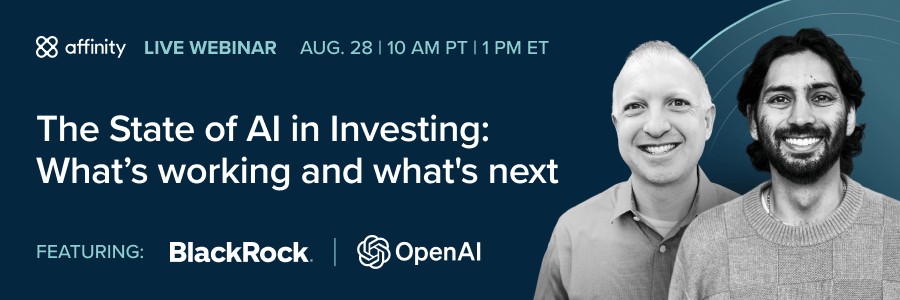👋 Hi, I’m Andre and welcome to my newsletter Data Driven VC which is all about becoming a better investor with Data & AI. Join 34,870 thought leaders from VCs like a16z, Accel, Index, Sequoia, and more to understand how startup investing becomes more data-driven, why it matters, and what it means for you.
ICYMI, check out our most read episodes:
Brought to you by Affinity - The State of AI Investing
AI is moving from concept to reality in private capital. Hear from experts at BlackRock, OpenAI, and Affinity as they explore how AI is reshaping workflows, unlocking new insights, and redefining what’s possible for deal teams.
This session is built for investors looking to understand where AI can drive real value and how to assess readiness across their portfolio and the broader ecosystem.
Entering the fast fashion era of SaaS..
I shared my take on Sam Altman’s recent tweet that “we’re entering the fast fashion era of SaaS very soon” on LinkedIn here.

The post triggered a controversial discussion with 139 comments (and counting) - something I really enjoy and one of the key reasons I regularly post online. Few better ways to challenge your thoughts at scale ;)
Today, I’d like to dive deeper on this topic and share:
How software development has changed and why there’s only 2 categories left: the hard and the easy build
“When building remains hard, winning gets easy. When building gets easy, winning gets hard.” - and how you can still win in an era where everyone can build
Scale, moats, and margins across the stack: Why the hard build gets rewarded today but the easy build has hope for tomorrow
Let’s dive in!
There’s only 2 categories of software left: the hard and the easy build
There’s no software company without AI anymore. This was different not too long ago.
Deconstructing the AI Landscape (2020)
In 2019, I conducted an internal deep dive at Earlybird about the implications of AI on businesses and established a simple framework that I also published in my “Deconstructing the AI Landscape” article.
Do you want to build a core-AI tech component which is applicable to variety of use cases and independent from a specific industry (horizontal), or do you aim to solve a very use-case- or domain-specific issue by applying AI (vertical)?
With this simple question, I split AI businesses into horizontal and vertical ones, and explored what it takes for either one of them to win.
Re-reading my medium post today, I’m frankly a bit surprised how little my perspective on the fundamentals has changed.
Yes, AI dominates the news and we keep pushing the boundaries on a daily basis. And of course we reflect this in more detailed frameworks as the one below from my 2023 “AI Cheat Sheet”.

But in its core, if we simplify to the lowest denominator, we only have 2 categories of AI businesses.
The two categories of AI businesses in 2025
While in the past I called them “horizontal / core AI / industry agnostic” and “vertical / application / industry specific” companies, I would slightly reframe and simplify even further today:
Hard to build - aka the horizontal ones: These are the companies that despite transformative AI innovations remain notoriously hard to build. They require deep technical expertise and sophisticated software development skills to create and scale complex architectures. Examples include infra companies (like Nvidia, HPE, Intel, GCP, Azure, AWS - and our portfolio company Arago), intelligence & foundation model companies (like Black Forest Labs, ElevenLabs, Mistral - and our portfolio company spAItial), middle layer companies (i.e. the picks and shovels like our portfolio companies TopK for hybrid databases or Aiven’s open source data platform), but also full-stack platforms (like Antrophic, OpenAI, Databricks, Microsoft, Google - and our portfolio company Aleph Alpha).
Do they use AI? Of course. Does it accelerate their delivery? Surely. And does AI reduce the entry barriers to build better competitors with ease? Well, actually no. At least not today. All of the above companies remain hard to build. AI or not.Easy to build - aka the vertical ones: Building these companies has massively changed in the last 12 months. With Lovable, Bolt, Cursor, Replit and likes we’ve seen entry barriers to build vertical or use case specific solutions almost disappear. Examples include anything you can classify as an “AI wrapper” such as the code-gen tools mentioned above but also (rather simple) use case specific products like DocuSign.





